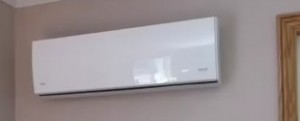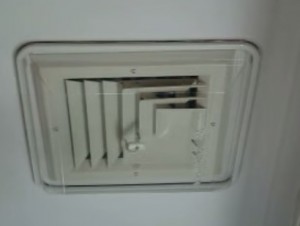Mini split units and central air conditioning are both good options for cooling a home.
Each has its own positives and negatives that should be considered before installing a system.
Main Differences Between a Mini Split and Central Air Conditioning
A mini split unit only blows air from one spot where the inside unit is located.

A central air conditioner cycles air through a building through ducts that blow out vents and returns to the A/C unit to cool the air again.

Advantages of a Mini Split
The main advantage of a mini split system is the initial cost, cheaper to run, and control over a section of a building to cool or not cool.
Mini splits are ideal when an open space needs to be cooled. Since there is no ductwork, the cool air doesn’t transmit past walls.
For this reason, mini splits are used in many small businesses, such as hotel/motel rooms, hair salons, and so on.
Another advantage of a mini split is they are cheaper to buy and much cheaper to run.
Advantages of a Central Air Conditioning
Central air is the standard way most homes are cooled and heated, with a unit sitting outside cycling air through a home via ducts.
A central air unit has the advantage of cooling an entire home to the same temperature.
Disadvantages of a Mini Split
The main disadvantage of a mini split is since there is no ductwork, cold or hot air will not travel well past the room it is placed in.
Disadvantages of Central Air Conditioning
Cost is the biggest downside to standard central air conditioning.
The cost to install a unit and ductwork is much more than a mini split system.
Since they cool the entire building, electrical costs are a lot more than a mini split.
Bottom Line
Mini splits and a standard central air conditioning unit both have their place.
Someone may only want to cool or heat one section of the house they are in and not the entire home; adding a mini split would solve this problem.
Some homes have add-ons that ductwork was never run to that a mini split would work perfectly for.
A central air conditioning unit will cool an entire home to the same temperature making them ideal for someone needing to cool a whole house.
When looking to buy a mini split or a central air conditioning unit, everyone will have a different situation that will need to be evaluated.
Hi Aaron,
Excellent job very informative
Do you mind if I ask the square foot of your home
and the btu size of your wall unit?
Thanks
Hello. Need to upgrade my heating system. Tenants basement apt has hot water baseboards oil. My unit upstairs is electric baseboards. An HVac today suggested Mitsubishi mini splits hyper heat for upstairs. My question and worry is if these mini splits will take care of the extreme cold temps in Massachusetts without any other back up heating? I hear heat pumps do not do well in extreme cold
I live in northern Arizona and my primary cooling is an evaporative cooler, which works very well except for July thru August. I live in a linear mobile home and think the split system will work well. I’m thinking of having two smaller systems for each end of the home.
What is the dimension of the compressor unit that you have? Do they come smaller? What is the brand you have? Can you recommend installers who are familiar with split systems in the Phoenix, Flagstaff, or Prescott areas?
Thank you for any advice you can give me.
A split system size is matched to the space that needs cooled or heated by the BTU it uses.
For example a 12,000 BTU unit can cool or heat a room up to 550 square feet.
Here is an example of the current top selling mini split on Amazon the Pioneer Ductless Wall Mount Mini Split which has four different sizes.
Most HVAC companies will have mini splits they recommend and have already.
A popular option for trailers is split units that works the same as a mini split but use what is called a A-Coil that is placed into the bottom of the heater unit. It uses the same duct work as the heater and blower motor to blow cold air through the vents.
A condenser is placed outside the same as a mini split and all that is run into the trailer is a line set to the A-coil that carries the freon in and out transferring heat or cold.
I know a lot of HVAC technicians in my area but not around Phoenix. Different HVAC companies would need to be called for installations prices.
Very valid, pithy, sucincct, and on point. WD.